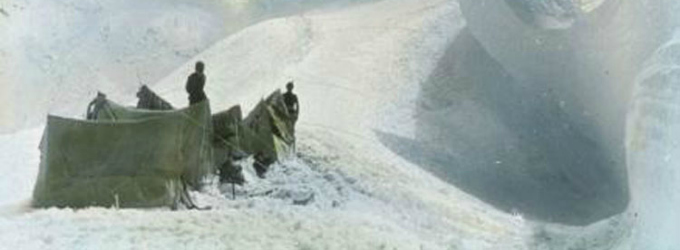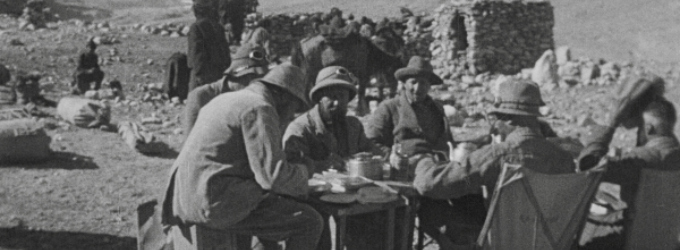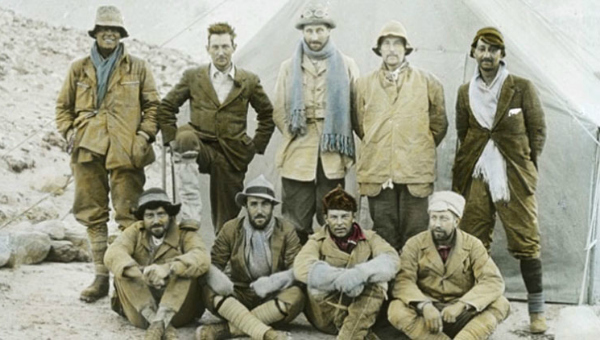 THE EPIC OF EVEREST was made and released in 1924: it’s the filmed record of George Mallory and Sandy Irvine’s expedition, in which they planned to be the first people to climb to the top of the world. Neither survived, and no one knows for sure if they made it. Watching the new and gorgeous digital restoration by the BFI National Archive, it’s impossible to forget those two facts.
THE EPIC OF EVEREST was made and released in 1924: it’s the filmed record of George Mallory and Sandy Irvine’s expedition, in which they planned to be the first people to climb to the top of the world. Neither survived, and no one knows for sure if they made it. Watching the new and gorgeous digital restoration by the BFI National Archive, it’s impossible to forget those two facts.
The context also matters – it’s only six years after the end of the Great War. All of the British expedition members had fought, with the exception of Irvine, who was too young. Well into the 1920s, many were unemployed, injured veterans who struggled to survive with very little welfare available. It was hardly Lloyd George’s promise of a ‘home fit for heroes’ (even if that phrase actually applied to the provision of council housing). On the world stage, the British Empire was dying, but its industrial achievements were being celebrated at the British Empire Exhibition, which opened in April 1924. Into this mix came an expedition that would prove the Empire was still strong. What is the film’s message? Is it propaganda? Apart from some incredibly patronising intertitles in the early scenes it doesn’t feel overtly so, although it certainly does promote stoicism in the face of adversity. THE EPIC also focuses on bravery, persistence, physical courage, a sense of exploration and adventure, and finally sacrifice. All of these qualities were the subjects of Great War propaganda; one wonders how that affected the audiences?
The restored footage has been tinted and toned as it was in the orginal, to represent dawn, cold, night and finally death. The slow pace of the expedition dictates the pace of the film; it takes a while to get used to it as a 21st century viewer. It feels like a newspaper article with moving images, which of course it was. The filmmaker Captain John Noel had cannily purchased rights to the footage before the expedition began, setting up a production company, Explorers Films, and raising money to buy land in Darjeeling to set up a lab. Here the rushes were developed and dispatched to Pathé Pictorial News for worldwide distribution. On Noel’s return to the UK, he released THE EPIC OF EVEREST to great acclaim and took the film on a lecture tour of Britain, Europe and the US. His daughter Sandra Noel has collaborated with the BFI National Archive, contributing her copy of the film to complement the one in the archive.
… it was so cold the camera froze to the face of one unfortunate crewmember.
THE EPIC OF EVEREST opens with long, languorous shots of the mountains: it’s a love song to mountaineering. Noel lingers in Phari, the world’s highest town, filming children, old people, monks, musicians and dancers. He also records Mallory and Irvine walking away from the inhabited world and into the mystery of the mountains, but only after the gods of Lamas predicted an unsuccessful outcome. Did spirits guard Everest from intruders? The expedition story is told with intertitles: some of them are, to our eyes, offensive or at least insensitive but they probably accurately reflect the prevailing attitudes to native peoples. Much is made of how dirty the Tibetan villagers are; one intertitle claimed that they never washed from birth to death. There’s no recognition of how challenging their entire lives must be in that harsh environment. Insensitive as the text is, it seems that the main purpose was to highlight the purity of the mountain and the aims of the expedition. Noel’s camera revels in the beauty of the craggy landscape. Low angles convey the enormity of the mountains. One remarkable scene follows a tiny man in the foreground at screen bottom right; he skirts the bottom of a towering ice cliff and walks towards the bottom of the screen, for all the world looking as though he would climb out of the frame!
Another intertitle reveals the sheer hard labour of mountaineering – thousands of ice steps had to be cut. As the journey progressed the large group dwindled, not because of casualties but because they remained at base camps; although two men died in a severe storm. The Ice Cliff camp was 23,000 ft above sea level, but the camera crew stopped at 21,000 ft, admitting that they were ‘physically incapable of carrying the camera any higher’. Nevertheless, high-powered camera lenses allowed them to observe the action from afar. Because of the thin air, they could film from two miles away and still see the tiny figures. Sandra Noel says that it was so cold the camera froze to the face of one unfortunate crewmember. It’s disconcerting to look on what must have been hell happening in miniature.

Mallory and Irving disappeared at 28,400ft, only 600ft from the summit – had they made it? After a fruitless two-day search, the rest of the expedition returned home. What a melancholy trudge back to civilisation that must have been. The search party indicated the deaths by laying out six blankets on the snow to make a cross, and an enormous cairn was constructed to their memory. Carrying news that would soon rock England, these few men trekked back to India. The final intertitles ask what better place for these men to be buried than in a ‘grave of pure white snow’, echoing the sentiments about purity set out at the beginning of the story.
Simon Fisher Turner’s score uses a mix of composed work, found sounds (some are from Sandra Noel’s father’s collection, so are contemporary with the film). Fisher Turner incorporates songs sung by locals, yak bells, electronica. While the score successfully creates an atmosphere of grandeur and melancholy, it relies heavily on sound effects directly linked to images – the dog barking, running water, a bell – disrupting the composed element. One wonders what tone the original score took – was it rousing, or melancholy?
It must have been a strange experience to produce the finished film, having witnessed the tragedy.
THE EPIC OF EVEREST is a perfect example of the power of the moving image to move our hearts. It’s disturbing and powerful to see four men returning from the Ice Cliff camp, when six had set out. It must have been a strange experience to produce the finished film, having witnessed the tragedy. By the time the complete version hit the screens in 1924, everyone knew the outcome. What was the effect? Was it meant to be a morale booster in those dark days? Did it remind people of the nobility of sacrifice or in some cases, its futility? Or had the national mood changed amid hopes of a brighter future?
The final intertitle asks if the expedition was always doomed given the gods’ dire prediction. Chris Bonnington once remarked that no one conquers a mountain like Everest, but now and again it’s possible to catch it with its back turned. It seems that on 8th June 1924 the mountain was watching Mallory and Irvine, and wouldn’t be letting them leave in one piece.
httpvh://youtu.be/MwuPmg68mKU


Thanks for that, Amanda – I especially valued the comments about the score.